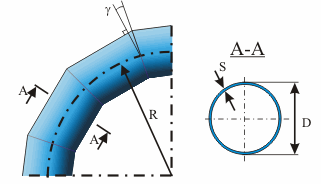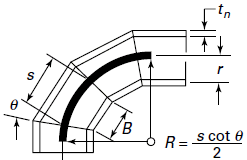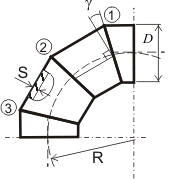



Closely spaced miter bends should satisfy the requirements of
ASME B31.1 code:


Other ASME B31 code:

If  or
or  the widely-spaced miter joints should be modeled using single
miter joint.
the widely-spaced miter joints should be modeled using single
miter joint.
A welded miter joint is made up of several miters and half-miters. Number of joints (with an axis direction change) is taken into account for intensification and flexibility factor analyses. Figure 1 shows a model with 3 joints. Skew angle is given for reference.
Central bend angle should not exceed 90 degrees (More...).

Fig. 1
START-PROF perform the Wall thickness check for Miter Bend according to selected code.

Property |
Description |
Name |
Element name. If checked then it shown in 3D view |
Qualified Bend |
If option is checked the mpsb=1 otherwise mpsb=1.3 is used |
Radius, R |
Bend average radius (0.5D<R<10D). Long - 1.5DN, short - 1.0DN |
Get properties from matching pipe |
Get properties from matching pipe |
Calculate weight automatically |
If selected, reducer weight is calculated automatically as frustum volume with wall thickness equal to that of adjoining pipes |
Weight |
Bend weight (with flanges) without insulation and product. Set according to standards without taking into account the overload factor. Product and insulation weight with corresponding overload factors are calculated automatically based on adjoining pipes. |
Calculate angle automatically |
The bend angle used in bend's flexibility factor (k-factor) calculation in some codes. The option "сalculate angle automatically" should be turned on by default. It is recommended to turn off this option when the bend was splitted into several parts to model the support on bend. In this case the angle should be specified for full bend, not for each part of bend |
Angle |
|
Material |
Material from materials database |
Longitudinal Weld Joint Efficiency Factor, E |
Longitudinal weld joint efficiency factor, E. More... |
Manufacturing technology |
For ASME B31.1, ASME B31.3, DL/T 5366-2014 seamless pipe will always use Wl=1.0. For electric-welded pipe Wl will be specified from database. More... When using GOST 32388-2013, pipe physical properties are taken from different materials databases depending on pipe type (seamless/welded). |
Presence of flanges |
Number of flanges must be selected. Flanges are rigid elements and prevent cross-section ovalization. Flanges affect the flexibility factor and stress intensification factor.
|
Number of miters |
Number of miters, see fig. 1 |
Skew angle |
Skew angle for each miter, see fig. 1 |
Mill tolerance |
Mill tolerance at the time of production. More... |
Corrosion and wear allowance |
Corrosion and wear allowance (working mill tolerance) for wall thickness. More... |
Nominal wall thickness, S |
Nominal (actual) wall thickness |
Stress correlation along two axes, r |
Based on ISO 14692 section 7.10
|
Qualified stress, qs |
If this field is blank then qs is got from material database Based on ISO 14692 section 7.8
|
Internal protective layer thickness |
|
External protective layer thickness |
|
To insert an elbow, select the desired node and use the menu option: Insert > Insert Bend > Miter Bend (Closely-spaced)
To view properties of an existing element:
Double-click the element in the 3D view
Select the
element and press the  toolbar icon
toolbar icon